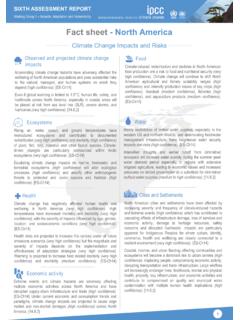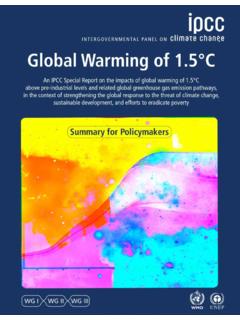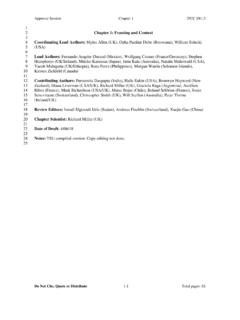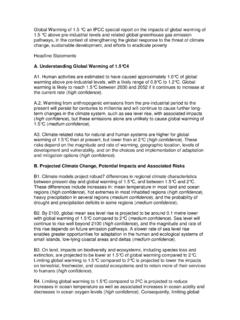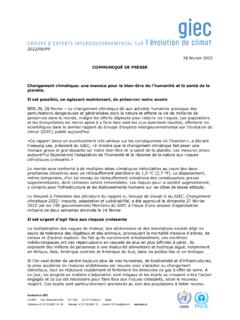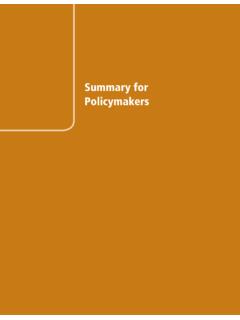Transcription of EDITS VERSION FINAL TO ACCEPTED SUBJECT
1 FINAL DRAFT Cross-Chapter Paper 5 IPCC WGII sixth assessment Report 1. 2 Cross-Chapter Paper 5: Mountains 3. 4 Cross-Chapter Paper Leads: Carolina Adler (Switzerland/Chile/Australia), Philippus Wester (Nepal/The 5 Netherlands). 6. 7 Cross-Chapter Paper Authors: Indra Bhatt (India), Christian Huggel (Switzerland), Gregory Insarov 8 (Russian Federation), Michael Morecroft (United Kingdom), Veruska Muccione (Switzerland/Italy), Anjal 9 Prakash (India). 10. 11 Cross-Chapter Paper Contributing Authors: Irasema Alc ntara-Ayala (Mexico), Simon K. Allen 12 (Switzerland/New Zealand), Maaike Bader (Germany), Sophie Bigler (Switzerland), James Camac 13 (Australia), Ritodhi Chakraborty (New Zealand/India), Aida Cuni Sanchez (Norway/Spain), Nicol s Cuvi 14 (Ecuador), Fabian Drenkhan (Peru/Germany), Abid Hussain (Nepal/Pakistan), Amina Maharjan (Nepal), 15 Robert Marchant (United Kingdom), Graham McDowell (Canada/USA), Samuel Morin (France), Laura 16 Niggli (Switzerland), Ana Ochoa (Ecuador), Avash Pandey (Nepal), Julio Postigo (USA/Peru), Estelle S.
2 17 Razanatsoa (South Africa/Madagascar), Valeria M. Rudloff (Chile), Christopher Scott (USA), Madison Stevens (Canada), Daithi Stone (New Zealand), Jessica Thorn (United Kingdom/Namibia), James Thornton IT. 18. 19 (Switzerland/United Kingdom), Daniel Viviroli (Switzerland), Saskia Werners (The Netherlands). AL N. 20. ED. Cross-Chapter Paper Review Editor: Georg Kaser (Austria). N IO. 21. 22. 23 Cross-Chapter Paper Scientist: Valeria M. Rudloff (Chile). FI S. 24. 25 Date of Draft: 1 October 2021. R. 26. 27 Notes: TSU Compiled VERSION TO E. 28. T DV. 29. 30 Table of Contents 31. 32 Executive Summary ..3. EC TE. 33 Point of Departure ..6. 34 Observed Impacts and Adaptation in Mountain Social-Ecological 35 Ecosystems and Ecosystem Services ..7. Box : Wildfires and Mountain Ecosystems ..9. BJ P. 36.
3 37 Water and Energy ..11. E. 38 Food, Fibre, and Other Mountain Ecosystem Products ..14. 39 Cities, Settlements and Key Infrastructure ..16. SU C. 40 Mountain Communities, Livelihoods, Health and Wellbeing ..17. 41 Natural Hazards and Disasters ..21. AC. 42 Synthesis of Observed Impacts and Attribution and Observed Adaptation ..22. 43 Projected Impacts and Risks in Mountains ..25. 44 Synthesis of Projected Impacts ..25. 45 Key Risks Across Sectors and Regions ..26. 46 Options for Adaptation and Climate Resilient Development Pathways ..31. 47 Synthesis of Adaptation Responses to Reducing (Key) 48 Challenges, Opportunities and the Solution Space for Adaptation in Mountains ..32. 49 Climate Resilient and Sustainable Development in Mountains ..34. 50 Key assessment Limitations and Relevant Knowledge Gaps.
4 35. 51 FAQ : How is freshwater from mountain regions affected by climate change, and what are the 52 consequences for people and ecosystems? ..37. 53 FAQ : Are people in mountain regions, and further downstream, facing more severe risks to 54 water-related disasters due to climate change, and how are they coping? ..38. 55 FAQ : Is climate change a risk to mountain species and ecosystems, and will this affect people? 56 ..39. Do Not Cite, Quote or Distribute CCP5-1 Total pages: 63. FINAL DRAFT Cross-Chapter Paper 5 IPCC WGII sixth assessment Report 1 FAQ : What type of adaptation options are feasible to address the impacts of climate change in 2 mountain regions under different levels of warming, and what are their limits? ..40. 3 FAQ : Why regional cooperation and transboundary governance is needed for sustainable 4 mountain development?
5 41. 5 References ..43. 6. 7. S. IT. AL N. ED. N IO. FI S. R. TO E. T DV. EC TE. BJ P. E. SU C. AC. Do Not Cite, Quote or Distribute CCP5-2 Total pages: 63. FINAL DRAFT Cross-Chapter Paper 5 IPCC WGII sixth assessment Report 1 Executive Summary 2. 3 Mountains are highly significant regions in the context of climate change and sustainable development, at the 4 intersection of accelerated warming and a large population depending directly or indirectly on them. They 5 are regions of high biological and cultural diversity and provide vital goods and services to people living in 6 and around mountain regions and in downstream areas. Building on the IPCC's Fifth assessment Report 7 (AR5), Chapter 2 High Mountain Areas of the Special Report on the Ocean and Cryosphere in a Changing 8 Climate (SROCC), and the IPCC Working Group I contribution to AR6, this Cross-Chapter Paper (CCP).
6 9 assesses new evidence on observed and projected climate change impacts in mountain regions, their 10 associated key risks and adaptation measures. 11. 12 Observed changes, their impacts, and adaptation responses in mountains 13. 14 Climate change impacts in mountains and their attribution to human influence have increased in 15 recent decades with observable and serious consequences for people and ecosystems in many mountain 16 regions (high confidence1). Observed changes include increasing temperatures, changing seasonal weather S. 17 patterns, reductions in snow cover extent and duration at low elevation, loss of glacier mass, increased permafrost thaw, and an increase in the number and size of glacier lakes (high confidence). { , IT. 18. 19 Figure , SROCC Chapter 2, WGI Section }. AL N.
7 20. ED. The spatial distributions of many plant species have shifted to higher elevations in recent decades, N IO. 21. 22 consistent with rising temperatures across most mountain regions (high confidence). Around two-thirds 23 of treeline ecotones have also shifted upwards in recent decades, though these shifts are not ubiquitous and 24. FI S. slower than expected based on rising temperatures (high confidence). Impacts on biological communities and 25 animal species are also increasingly being reported, with species of lower elevations increasing in mountain R. 26 regions, creating more homogeneous vegetation and increasing risks to mountain top species (medium 27 confidence). { ; Chapter }. TO E. 28. T DV. 29 Climate and cryosphere change have negatively affected the water cycle in mountains, including 30 variable timing of glacier- and snow-melt stream discharge (high confidence).
8 These changes have 31 variable impacts on water availability for people and economies, contributing to increasing tensions or 32 conflicts over water resources, especially in seasonally dry regions (medium confidence). Mountains are an essential source of freshwater for large, and growing populations; the number of people largely or fully EC TE. 33. 34 dependent on water from mountains has increased worldwide from ~ billion in the 1960s to ~2 billion in 35 the past decade and globally two-thirds of irrigated agriculture depends on essential runoff contributions 36 from the mountains. { ; Figure ; SROCC Chapter 2; ; }. BJ P. 37. Climate change-driven changes in precipitation, river flow regimes and landslides affect the E. 38. 39 production and use of energy in mountain regions, in particular hydropower (high confidence).
9 SU C. 40 Billions of USD in investment and assets of energy production are exposed to changing mountain hazards. 41 Combined effects of climate change, hydropower development and other human interventions have AC. 42 exacerbated water security problems and social injustice (medium confidence). { , SROCC Chapter 43 2}. 44. 45 Observed climate-driven impacts on mountain ecosystem services, agriculture and pastoralism are 46 largely negative in most mountain regions (medium confidence). Agriculture has been negatively affected 47 through increased exposure to hazards such as droughts and floods, changes in the onset of seasons, the 48 timing and availability of water, increasing pests and decreasing pollinator diversity, which in turn have 49 negatively influenced overall production, dietary diversity and nutritional value (medium confidence).
10 50 Negative climate impacts on pastoralism, such as drought induced degradation of rangelands and pastures, 51 have affected livestock productivity and livelihood of pastoralists, while other non-climatic factors such as 1. In this Report, the following summary terms are used to describe the available evidence: limited, medium, or robust;. and for the degree of agreement: low, medium, or high. A level of confidence is expressed using five qualifiers: very low, low, medium, high, and very high, and typeset in italics, , medium confidence. For a given evidence and agreement statement, different confidence levels can be assigned, but increasing levels of evidence and degrees of agreement are correlated with increasing confidence. Do Not Cite, Quote or Distribute CCP5-3 Total pages: 63. FINAL DRAFT Cross-Chapter Paper 5 IPCC WGII sixth assessment Report 1 land-use change and management also play a role (medium confidence).
